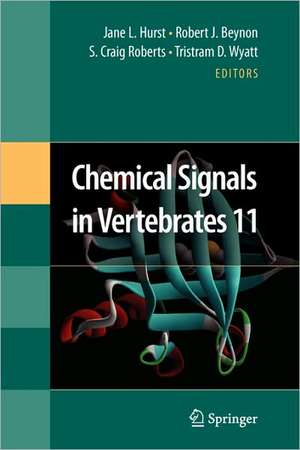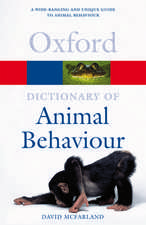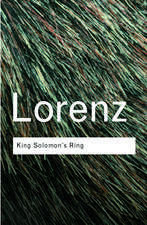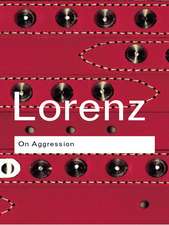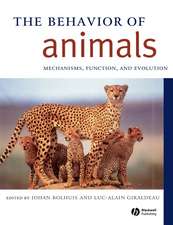Chemical Signals in Vertebrates 11
Editat de Jane Hurst, Robert J. Beynon, S. Craig Roberts, Tristram Wyatten Limba Engleză Paperback – 28 oct 2010
| Toate formatele și edițiile | Preț | Express |
|---|---|---|
| Paperback (1) | 1387.91 lei 6-8 săpt. | |
| Springer – 28 oct 2010 | 1387.91 lei 6-8 săpt. | |
| Hardback (1) | 1391.83 lei 6-8 săpt. | |
| Springer – 28 noi 2007 | 1391.83 lei 6-8 săpt. |
Preț: 1387.91 lei
Preț vechi: 1692.57 lei
-18% Nou
Puncte Express: 2082
Preț estimativ în valută:
265.57€ • 278.03$ • 219.75£
265.57€ • 278.03$ • 219.75£
Carte tipărită la comandă
Livrare economică 05-19 aprilie
Preluare comenzi: 021 569.72.76
Specificații
ISBN-13: 9781441925398
ISBN-10: 1441925392
Pagini: 460
Ilustrații: XXV, 432 p.
Dimensiuni: 155 x 235 x 24 mm
Greutate: 0.64 kg
Ediția:Softcover reprint of hardcover 1st ed. 2008
Editura: Springer
Colecția Springer
Locul publicării:New York, NY, United States
ISBN-10: 1441925392
Pagini: 460
Ilustrații: XXV, 432 p.
Dimensiuni: 155 x 235 x 24 mm
Greutate: 0.64 kg
Ediția:Softcover reprint of hardcover 1st ed. 2008
Editura: Springer
Colecția Springer
Locul publicării:New York, NY, United States
Public țintă
ResearchDescriere
This volume reports the proceedings of the eleventh triennial meeting of the Chemical Signals in Vertebrates International Symposium and thus, is the 30th anniversary of the informal grouping of scientists who convene to discuss their common interests in the ways in which vertebrates use chemical signals. Pre- ous meetings were held in Saratoga Springs, New York; Syracuse, New York; Sarasota, Florida; Laramie, Wyoming; Oxford, England; Philadelphia, Pennsyl- nia; Tubingen,Germany;Ithaca, New York; Krakow ´ ,Poland and Corvallis, Oregon. The eleventh meeting was hosted by the Faculty of Veterinary Science at the University of Liverpool, and was held in Chester, England. CSiV 11 was the latest in a well regarded series of meetings, and was attended by about 80 scientists, with nearly120 furtherco-authors,all with a commoninterest in vertebratechemicals- nalling, and its role in vertebrate behaviour. The species range was, as ever, rema- able – from lion to salamander, from mouse to elephant, from salmon to human, a biodiversity matched by the range of the substances used for communication. As might be expected from such diversity, we enjoyed a broad ranging programme that included sessions on olfactory assessment, pheromone delivery, sexual sel- tion (human and animal), urinary proteins, anti-predator responses, scent organs and their function, individual recognition, species recognition, sexual development and sexual communication (the full programme can still be viewed on the CSiV website).
Cuprins
New Directions in Semiochemistry.- Volatile Mammalian Chemosignals: Structural and Quantitative Aspects.- Use of Automated Solid Phase Dynamic Extraction (SPDE)/GC-MS and Novel Macros in the Search for African Elephant Pheromones.- Urinary Lipocalins in Rodenta:is there a Generic Model?.- The Biological Function of Cauxin, a Major Urinary Protein of the Domestic Cat (Felis catus).- Putative Pheromones of Lion Mane and Its Ultrastructure.- Olfactory Response and Function.- Using Ethologically Relevant Tasks to Study Olfactory Discrimination in Rodents.- Comparisons of State and Likelihood of Performing Chemosensory Event Behaviors in Two Populations of African Elephants (Loxodonta africana).- Olfactory Communication in the Ringtailed Lemur (Lemur catta): Form and Function of Multimodal Signals.- Olfaction in the Gorilla.- Ecological Validity in the Study of Human Pheromones.- The Influence of Sexual Orientation on Human Olfactory Function.- Recognition within Species: Individual, Sex, Group.- MHC-Associated Chemosignals and Individual Identity.- Pregnancy Block from a Female Perspective.- The Wing-Sac Odour of Male Greater Sac-Winged Bats Saccopteryx bilineata (Emballonuridae) as a Composite Trait: Seasonal and Individual Differences.- Gender Specific Expression of Volatiles in Captive Fossas (Cryptoprocta ferox) During the Mating Season.- Do Spotted Hyena Scent Marks Code for Clan Membership?.- The Ontogeny of Pasting Behavior in Free-living Spotted Hyenas, Crocuta crocuta.- Human Body Odour Individuality.- Environmental Effects on Human Body Odour.- Sexual Communication.- A Candidate Vertebrate Pheromone, SPF, Increases Female Receptivity in a Salamander.- Cross-dressing in Chemical Cues: Exploring ‘She-maleness’ in Newly-emerged Male Garter Snakes.- The Neurobiology of Sexual Solicitation: Vaginal Marking in Female Syrian Hamsters (Mesocricetus auratus).- Olfactory Control of Sex-Recognition and Sexual Behavior in Mice.- The Role of Early Olfactory Experience in the Development of Adult Odor Preferences in Rodents.- Have Sexual Pheromones Their Own Reward System in the Brain of Female Mice?.- The Effect of Familiarity on Mate Choice.- Age of the Subject and Scent Donor Affects the Amount of Time that Voles Self-Groom When They are Exposed to Odors of Opposite-sex Conspecifics.- Scent, Mate Choice and Genetic Heterozygosity.- Maternal - Offspring Communication.- Psychobiological functions of the mammary pheromone in newborn rabbits.- Rabbit Nipple-Search Pheromone Versus Rabbit Mammary Pheromone Revisited.- The Human Breast as a Scent Organ: Exocrine structures, Secretions, Volatile Components, and Possible Functions in Breastfeeding Interactions.- Responses of Pre-term Infants to the Odour of Mother’s Milk.- Communication between Species, Predators and Prey.- Patterns of Tongue-Flicking by Garter Snakes (Thamnophis sirtalis) during Presentation of Chemicals under Varying Conditions.- Multi-Contextual use of Chemosignals by Liolaemus Lizards.- Selective Response of Medial Amygdala Subregions to Reproductive and Defensive Chemosignals from Conspecific and Heterospecific Species.- Seasonal Responses to Predator Faecal Odours in Australian Native Rodents Vary Between Species.- Applications.- A Critical Review of Zoo-based Olfactory Enrichment.- Pig Semiochemicals and Their Potential for Feral Pig Control in NE Australia.- Use of Chemical Ecology for Control of the Cane Toad?.
Textul de pe ultima copertă
This volume presents the proceedings of "Chemical Signals in Vertebrates 11", hosted by the University of Liverpool and held July 25 - 28, 2006 at the University of Chester in the United Kingdom. Chemical Signals in Vertebrates 11 contains the latest research on chemical communication relevant to vertebrates, particularly focusing on new research since the last meeting in 2003. Topics covered include chemical ecology, biochemistry, behavior and neurobiology of both the main olfactory and vomeronasal systems of vertebrates, from amphibia to mammals including humans. A broad range of taxonomic groups and topics are discussed, including sections on new directions in semiochemistry, olfactory response and function, recognition within species, sexual communication, maternal-offspring communication, communication between species, and applications for zoo animal enrichment and pest control. The volume is dedicated to the memory of Dr. Bets Rasmussen and includes a special tribute chapter on her ground-breaking research on elephant communication.
About the Editors:
Dr. Jane L. Hurst is a Professor in the Faculty of Veterinary Science at the University of Liverpool, Liverpool, UK, where she heads the Mammalian Behaviour and Evolution Research Group. Dr. Rob Beynon is also a Professor in the Faculty of Veterinary Science at the University of Liverpool, Liverpool, UK where he heads the Proteomics and Functional Genomics Research Group. Dr. S. Craig Roberts is a Lecturer in the School of Biological Sciences at the University of Liverpool, Liverpool, UK where he is a member of the Evolutionary Psychology Research Group. Dr. Tristram Wyatt is the Director of Distance and Online Learning at the University of Oxford, Oxford, UK and also a research associate at the Department of Zoology.
About the Editors:
Dr. Jane L. Hurst is a Professor in the Faculty of Veterinary Science at the University of Liverpool, Liverpool, UK, where she heads the Mammalian Behaviour and Evolution Research Group. Dr. Rob Beynon is also a Professor in the Faculty of Veterinary Science at the University of Liverpool, Liverpool, UK where he heads the Proteomics and Functional Genomics Research Group. Dr. S. Craig Roberts is a Lecturer in the School of Biological Sciences at the University of Liverpool, Liverpool, UK where he is a member of the Evolutionary Psychology Research Group. Dr. Tristram Wyatt is the Director of Distance and Online Learning at the University of Oxford, Oxford, UK and also a research associate at the Department of Zoology.
Caracteristici
Presents the newest research in chemical communication of vertebrates
Includes the potential application of novel techniques currently used in invertebrate systems
Covers a broad range of taxonomic groups, including humans
Includes the potential application of novel techniques currently used in invertebrate systems
Covers a broad range of taxonomic groups, including humans
